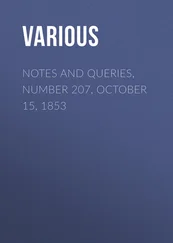Various - Notes and Queries, Number 34, June 22, 1850
Здесь есть возможность читать онлайн «Various - Notes and Queries, Number 34, June 22, 1850» — ознакомительный отрывок электронной книги совершенно бесплатно, а после прочтения отрывка купить полную версию. В некоторых случаях можно слушать аудио, скачать через торрент в формате fb2 и присутствует краткое содержание. Жанр: foreign_antique, periodic, foreign_edu, на английском языке. Описание произведения, (предисловие) а так же отзывы посетителей доступны на портале библиотеки ЛибКат.
- Название:Notes and Queries, Number 34, June 22, 1850
- Автор:
- Жанр:
- Год:неизвестен
- ISBN:нет данных
- Рейтинг книги:3 / 5. Голосов: 1
-
Избранное:Добавить в избранное
- Отзывы:
-
Ваша оценка:
- 60
- 1
- 2
- 3
- 4
- 5
Notes and Queries, Number 34, June 22, 1850: краткое содержание, описание и аннотация
Предлагаем к чтению аннотацию, описание, краткое содержание или предисловие (зависит от того, что написал сам автор книги «Notes and Queries, Number 34, June 22, 1850»). Если вы не нашли необходимую информацию о книге — напишите в комментариях, мы постараемся отыскать её.
Notes and Queries, Number 34, June 22, 1850 — читать онлайн ознакомительный отрывок
Ниже представлен текст книги, разбитый по страницам. Система сохранения места последней прочитанной страницы, позволяет с удобством читать онлайн бесплатно книгу «Notes and Queries, Number 34, June 22, 1850», без необходимости каждый раз заново искать на чём Вы остановились. Поставьте закладку, и сможете в любой момент перейти на страницу, на которой закончили чтение.
Интервал:
Закладка:
Various
Notes and Queries, Number 34, June 22, 1850 / A Medium of Inter-communication for Literary Men, Artists, Antiquaries, Genealogists, etc
Notes
THE "AGAPEMONE" OF THE SIXTEENTH CENTURY
As it is not generally known that the "Agapemone" had a prototype in the celebrated Family of Love , some account of this "wicked sect" may not at this moment be without interest to your readers:—
"Henry Nicholas, a Westphalian, born at Munster, but who had lived a great while at Amsterdam, and some time likewise at Embden, was the father of this family. He appeared upon the stage about the year 1540, styled himself the deified man , boasted of great matters, and seemed to exalt himself above the condition of a human creature. He was, as he pretended, greater than Moses and Christ, because Moses had taught mankind to hope , Christ to believe , but he to love ; which last being of more worth than both the former, he was consequently greater than both those prophets."—See Brandt's Hist. of the Reform, &c., in the Low Countries , vol. i. p. 105, ed. 1720.
According to some writers, however, the sect was not founded by Henry Nicholas, but by David George, an Anabaptist enthusiast of Delft, who died in 1556; and indeed there is some reason to believe that the Family of Love grew out of the heresies of the said George, with whom Nicholas had been on friendly terms.
"'Not content,' says Fuller, speaking of Nicholas, 'to confine his errors to his own country, over he comes into England, and in the latter end of the reign of Edward the Sixth, joyned himself to the Dutch congregation in London, where he seduced a number of artificers and silly women.'"— Church. Hist. , p. 112, ed. 1655.
On the 12th of June, 1575, according to the historian Hollinshed,
"Stood at Paule's Crosse five persons, Englishmen, of the sect termed the Familie of Love, who there confessed themselves utterlie to detest as well the author of that sect, H. N., as all his damnable errors and heresies."
A curious little volume on the history and doctrines of this sect appeared in the year 1572, from the pen of John Rogers, entitled The Displaying of an horrible Secte of grosse and wicked Heretiques, naming themselves the Family of Love, with the Lives of their Authors, and what Doctrine they teach in Corners. Imprinted at London for George Bishop. 1579. 12mo. Christopher Vittall, a joiner of Southwark, who had been infected with the doctrine of Arius some twenty years before, and whose credit was great amongst the Family of Love , was at this period actively engaged in teaching their doctrines. He travelled about the country to disseminate them; and was likewise author of a little book, in reply to Roger's Displaying of the sect, printed in the same year.
At the close of the year 1580 the sect was increasing so rapidly in England, that the government took active measures for its suppression, and the Queen issued a proclamation to search for the "teachers or professors of the foresaid damnable sect," and to "proceed severelie against them." This proclamation may be seen in Hollinshed and in Camden's Annals . 1 1 Footnote 1: It was reprinted in Notes and Queries, Vol. i. p. 17.
After the death of Queen Elizabeth—
"The Family of Love (or Lust rather)," according to Fuller, "presented a tedious petition to King James, so that it is questionable whether his Majesty ever graced it with his perusall, wherein they endeavoured to cleare themselves from some misrepresentations, and by fawning expression to insinuate themselves into his Majesty's good opinion."
After printing the petition Fuller proceeds—
"I finde not what effect this their petition produced, whether it was slighted and the petitioners looked upon as inconsiderable, or beheld as a few frantick folk out of their wits, which consideration alone often melted their adversaries' anger into pity unto them. The main design driven on in the petition is, to separate themselves from the Puritans (as persons odious to King James), that they might not fare the worse for their vicinity unto them; though these Familists could not be so desirous to leave them as the others were glad to be left by them. For if their opinions were so senseless, and the lives of these Familists so sensuall as is reported, no purity at all belonged unto them."
The Family of Love , after being exposed and ridiculed both in "prose and rime," finally "gave up the ghost," and was succeeded by another "wicked sect" denominated the Ranters .
Edward F. Rimbault.PUNISHMENT OF DEATH BY BURNING
A woman was strangled and burnt for coining in front of the Debtors door, Newgate, on the 10th of March, 1789. I believe this to be the last instance in which this old punishment was inflicted, at least in the metropolis. The burning part of the ceremony was abolished by the 30 Geo. III., c. 48., and death by hanging made the penalty for women in cases of high or petty treason. E. S. S. W.'s informants are wrong in supposing that the criminals were burnt whilst living. The law, indeed, prescribed it, but the practice was more humane. They were first strangled; although it sometimes happened that, through the bungling of the executioner, a criminal was actually burnt alive, as occurred in the celebrated case of Katherine Hayes, executed for the murder of her husband in 1726. The circumstances of this case are so remarkable, that, having referred to it, I am induced to recapitulate the chief of them, in the belief that they will interest your readers. Hayes, who was possessed of some little property, lodged with his wife Katherine in Tyburn, now Oxford Road. Mrs. Hayes prevailed upon two men, named Billings (who lodged in the house) and Wood, a friend of Hayes, to assist her in murdering her husband. To facilitate that object, Hayes was induced to drink the enormous quantity of seven bottles (at that time full quarts) of Mountain wine, besides other intoxicating drinks. After finishing the seventh bottle he fell on the floor, but soon after arose and threw himself on a bed. There, whilst in a state of stupefaction, he was despatched by Billings and Wood striking him on the head with a hatchet. The murderers then held council as to the best mode of concealing their crime, and it was determined that they should mutilate and dispose of the body. They cut off the head, Mrs. Hayes holding a pail to catch the blood; and she proposed that the head should be boiled until the flesh came from the skull. This advice was rejected on account of the time which the process suggested would occupy, and Billings and Wood carried the head in the pail (it was at night) to the Horseferry at Westminster, and there cast it into the Thames. On the following day the murderers separated the limbs from the body, and wrapping them, together with the trunk, in two blankets, carried them to Marylebone fields, and placed them in a pond. Hayes' head not having been carried away by the tide, as the murderers expected it would have been, was found floating at the Horseferry in the morning. The attention of the authorities was drawn to the circumstance, and the magistrates being of opinion that a murder had been committed, caused the head to be washed and the hair combed out, and then had it placed on a pole and exposed to public view in St. Margaret's churchyard, in the hope that it might lead to the discovery of the suspected crime. Great crowds of persons of all ranks flocked to St. Margaret's churchyard to see the head, and amongst the rest a young man named Bennett, who perceiving the likeness to Hayes, whom he knew, immediately went to Mrs. Hayes on the subject; but she assured him that her husband was alive and well, which satisfied him.
Читать дальшеИнтервал:
Закладка:
Похожие книги на «Notes and Queries, Number 34, June 22, 1850»
Представляем Вашему вниманию похожие книги на «Notes and Queries, Number 34, June 22, 1850» списком для выбора. Мы отобрали схожую по названию и смыслу литературу в надежде предоставить читателям больше вариантов отыскать новые, интересные, ещё непрочитанные произведения.
Обсуждение, отзывы о книге «Notes and Queries, Number 34, June 22, 1850» и просто собственные мнения читателей. Оставьте ваши комментарии, напишите, что Вы думаете о произведении, его смысле или главных героях. Укажите что конкретно понравилось, а что нет, и почему Вы так считаете.












